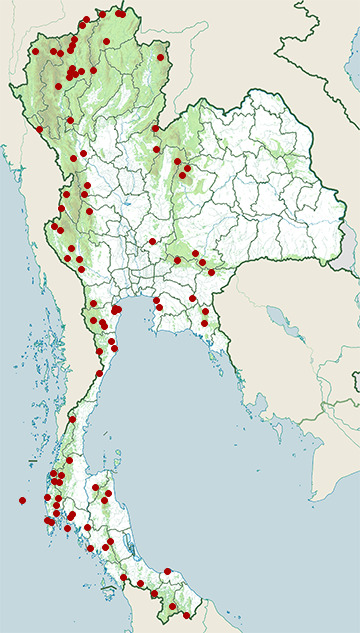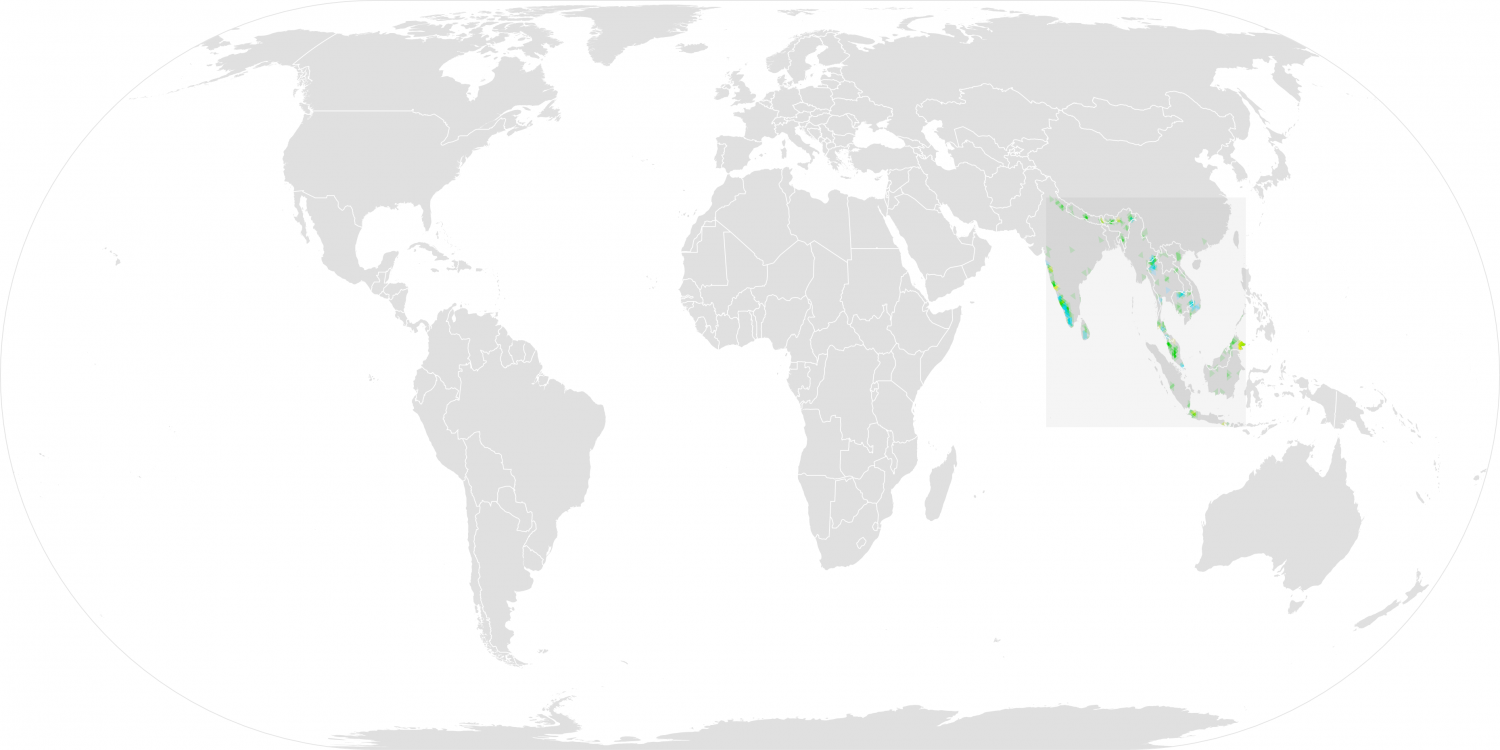Species of Thailand
Banded bay cuckoo
Cacomantis sonneratii
John Aubrey Clarendon Latham, 1790
In Thai: นกคัคคูลาย
The banded bay cuckoo or bay-banded cuckoo (Cacomantis sonneratii) is a species of small cuckoo found in the Indian subcontinent and Southeast Asia. Like others in the genus they have a round nostril. They are usually founded in well wooded areas mainly in the lower hills. Males sing from exposed branches during the breeding season, which can vary with region. They are distinctive both in their calls as well as plumage with a white eyebrowed appearance and the rufous upperparts with regular dark bands and the whitish underside with fine striations.
Description
The adults are bright rufous or bay on the head and back and are broadly barred with dark brown. The bill is long and slightly curved. A whitish supercilium is distinctive above a dark eye-line. The wing is darker and tail is graduated with a dark brown centre. The tail has a subterminal black band and white tips to the feathers. The sexes are alike. The iris is yellow and the bill is black while the base of the lower mandible is greenish grey. The tarsi are grey. The juvenile is similar but has a pale lower mandible and white fringes to the feathers of the upper body.
The overall length is about 22 cm making it about the same size as the syntopic Cacomantis merulinus and Cacomantis variolosus. The hepatic forms of those can be similar but supercilium, long beak and barred tail distinguish this species.
Taxonomy and systematics
The species was originally classed in the genus Cuculus by John Latham. The type specimen came from Northeastern India. The species epithet is after the French naturalist and explorer Pierre Sonnerat.
Four subspecies are generally recognized:
- the nominate form from India, Nepal, Thailand, Malay Peninsula
- C. s. musicus Ljungh, 1804 (from Java, Bali)
- C. s. fasciolatus Müller, 1843 (Sumatra)
- C. s. waiti Baker, 1919 (Sri Lanka)
Some sources also recognize malayanus (Chasen & Kloss, 1931) from Peninsular Malaysia and schlegeli (Junge, 1948) from Sumatra, Borneo and Palawan (SW Philippines).
Ecology and behaviour
Like many other cuckoos, they are brood-parasitic and hosts recorded include the common iora, red-whiskered bulbul, white-bellied erpornis, scarlet minivet, bulbuls and small babblers (Stachyris spp.). The eggs resemble those of the hosts. The incubation and nesting are not well documented. Fledglings of the host are evicted.
Populations are often migratory or partially migratory. In India, they are found mainly during the monsoons.
They are found in well-wooded forests, mainly in hill areas. Insects are their primary diet. They capture insects by gleaning as well as by aerial sallying.
The breeding season varies widely from region to region. Near Bombay they are known to lay eggs from February to August, Assam from April to August while they seem to sing through much of the year in the Eastern Ghats. In Sri Lanka, young have been seen in June and October while adults sing from January to May in the Malay Peninsula.
The call of this species is distinctive. It is high-pitched four note whistle that has been transcribed as "wee-ti wee-tee" or "smoke-yer-pepper". The frequency starts at 2.4 kHz and each note falls in pitch with the strophe lasting a second.
This article uses material from Wikipedia released under the Creative Commons Attribution-Share-Alike Licence 3.0. Eventual photos shown in this page may or may not be from Wikipedia, please see the license details for photos in photo by-lines.
Category / Seasonal Status
BCST Category: Recorded in an apparently wild state within the last 50 years
BCST Seasonal status: Resident or presumed resident
Scientific classification
- Kingdom
- Animalia
- Phylum
- Chordata
- Class
- Aves
- Order
- Cuculiformes
- Family
- Cuculidae
- Genus
- Cacomantis
- Species
- Cacomantis sonneratii
Common names
- Thai: นกคัคคูลาย
Subspecies
Cacomantis sonneratii fasciolatus, Salomon Müller, 1843
Range: Sumatra, Borneo and SW Philippines (Palawan)
Cacomantis sonneratii musicus, Sven Ingemar Ljungh, 1804
Range: Java, also recorded in Bali
Cacomantis sonneratii sonneratii (nominate), John Aubrey Clarendon Latham, 1790
Range: India, Nepal and Bhutan through Bangladesh and Myanmar to South China, Thailand and Indochina, and Peninsular Malaysia
Cacomantis sonneratii waiti, Edward Charles Stuart Baker, 1919
Range: Sri Lanka
Synonyms
- Penthoceryx sonneratii
Conservation status

Least Concern (IUCN3.1)
Photos
Please help us review the bird photos if wrong ones are used. We can be reached via our contact us page.
Range Map

- Ao Phang-Nga National Park
- Ban Laem District, Phetchaburi
- Bang Lang National Park
- Chae Son National Park
- Chiang Dao District, Chiang Mai
- Chiang Dao Wildlife Sanctuary
- Chiang Saen District, Chiang Rai
- Doi Inthanon National Park
- Doi Lang
- Doi Pha Hom Pok National Park
- Doi Phu Kha National Park
- Doi Saket District, Chiang Mai
- Doi Suthep - Pui National Park
- Erawan National Park
- Hala-Bala Wildlife Sanctuary
- Hat Chao Mai National Park
- Huai Kha Khaeng Wildlife Sanctuary
- Huai Nam Dang National Park
- Huai Yang Waterfall National Park
- Kaeng Krachan District, Phetchaburi
- Kaeng Krachan National Park
- Kaeng Krung National Park
- Khao Ang Rue Nai Wildlife Sanctuary
- Khao Banthat Wildlife Sanctuary
- Khao Khitchakut National Park
- Khao Laem National Park
- Khao Lak - Lam Ru National Park
- Khao Luang National Park
- Khao Nam Khang National Park
- Khao Nan National Park
- Khao Phanom Bencha National Park
- Khao Phra - Bang Khram Wildlife Sanctuary
- Khao Phra Thaeo Wildlife Sanctuary
- Khao Sam Roi Yot National Park
- Khao Soi Dao Wildlife Sanctuary
- Khao Sok National Park
- Khao Yai National Park
- Khlong Lan National Park
- Khlong Saeng Wildlife Sanctuary
- Khon San District, Chaiyaphum
- Khura Buri District, Phang Nga
- Kromluang Chumphon Wildlife Sanctuary
- Kui Buri National Park
- Mae Fa Luang District, Chiang Rai
- Mae Moei National Park
- Mae Ping National Park
- Mae Rim District, Chiang Mai
- Mae Wong National Park
- Mueang Chiang Mai District, Chiang Mai
- Mueang Chonburi District, Chonburi
- Mueang Krabi District, Krabi
- Mueang Pattani District, Pattani
- Mueang Phang Nga District, Phang Nga
- Mueang Phetchaburi District, Phetchaburi
- Mueang Tak District, Tak
- Nam Nao National Park
- Namtok Mae Surin National Park
- Nong Bong Khai Non-Hunting Area
- Op Khan National Park
- Pachee River Wildlife Sanctuary
- Pai District, Mae Hong Son
- Pak Thale
- Pang Sida National Park
- Pha Daeng National Park
- Phan District, Chiang Rai
- Phi Phi Islands
- Phu Hin Rong Kla National Park
- Phu Khiao Wildlife Sanctuary
- Phu Suan Sai National Park
- Pran Buri District, Prachuap Khiri Khan
- Sai Yok District, Kanchanaburi
- Sai Yok National Park
- Sakaerat Environmental Research Station
- San Kala Khiri National Park
- Sangkhla Buri District, Kanchanaburi
- Si Racha District, Chonburi
- Similan Islands
- Sirinat National Park
- Sri Nakarin Dam National Park
- Sri Phang-nga National Park
- Tai Rom Yen National Park
- Taksin Maharat National Park
- Tha Yang District, Phetchaburi
- Thale Ban National Park
- Thap Lan National Park
- Thung Yai Naresuan Wildlife Sanctuary
- Ton Pariwat Wildlife Sanctuary
- Umphang Wildlife Sanctuary
- Wat Tham Erawan Non-Hunting Area
- Yan Ta Khao District, Trang


